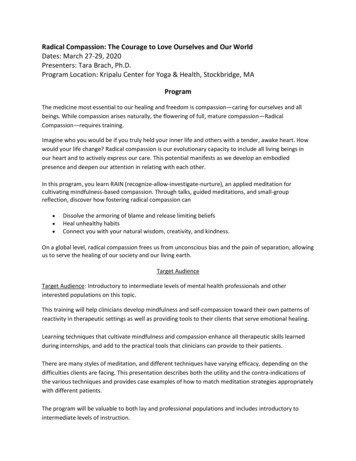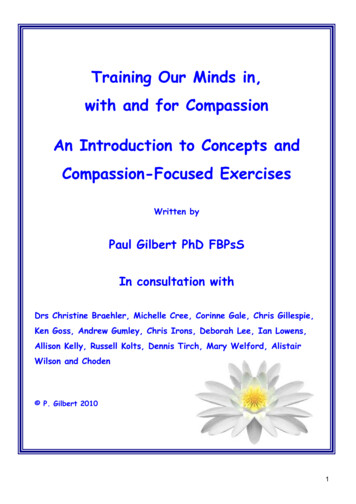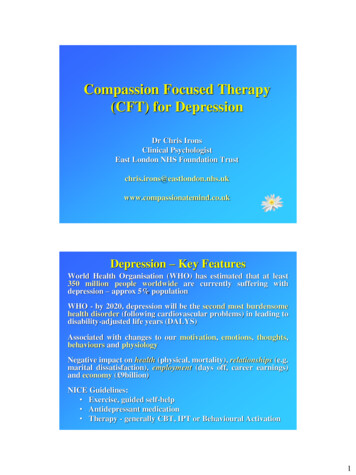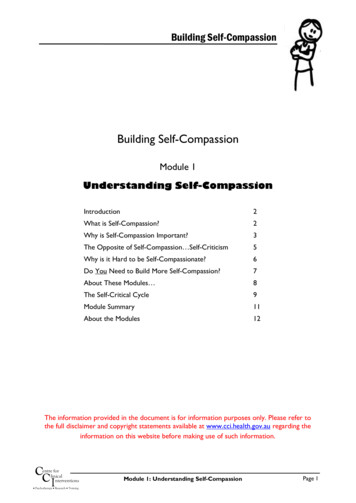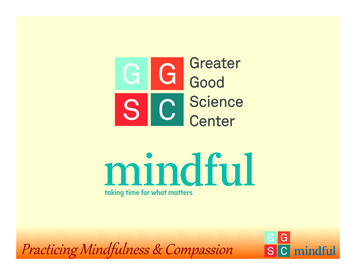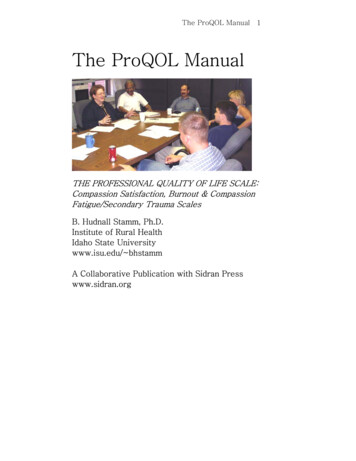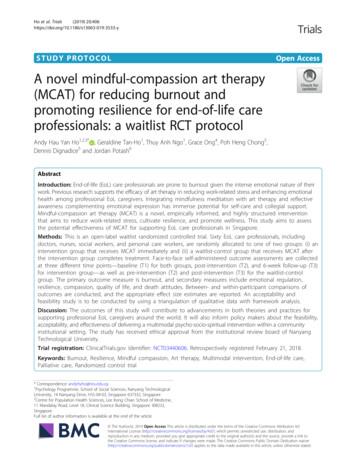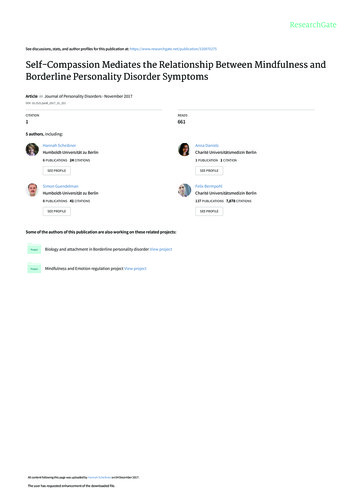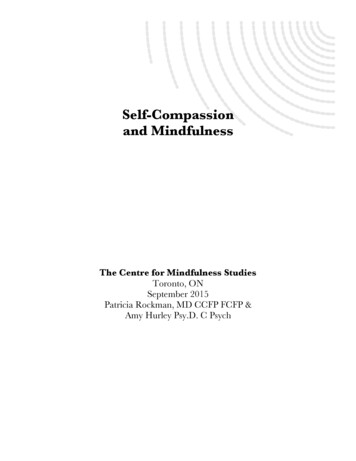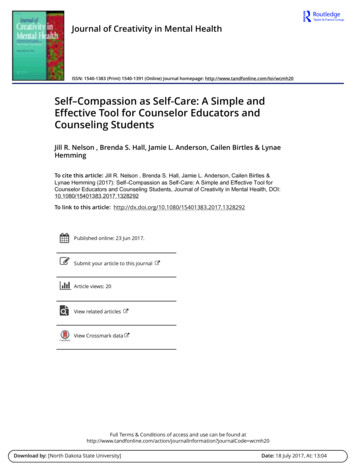
Transcription
Journal of Creativity in Mental HealthISSN: 1540-1383 (Print) 1540-1391 (Online) Journal homepage: sion as Self-Care: A Simple andEffective Tool for Counselor Educators andCounseling StudentsJill R. Nelson , Brenda S. Hall, Jamie L. Anderson, Cailen Birtles & LynaeHemmingTo cite this article: Jill R. Nelson , Brenda S. Hall, Jamie L. Anderson, Cailen Birtles &Lynae Hemming (2017): Self–Compassion as Self-Care: A Simple and Effective Tool forCounselor Educators and Counseling Students, Journal of Creativity in Mental Health, DOI:10.1080/15401383.2017.1328292To link to this article: lished online: 23 Jun 2017.Submit your article to this journalArticle views: 20View related articlesView Crossmark dataFull Terms & Conditions of access and use can be found tion?journalCode wcmh20Download by: [North Dakota State University]Date: 18 July 2017, At: 13:04
JOURNAL OF CREATIVITY IN MENTAL 2Self–Compassion as Self-Care: A Simple and Effective Toolfor Counselor Educators and Counseling StudentsJill R. Nelson , Brenda S. Hall, Jamie L. Anderson, Cailen Birtles,and Lynae HemmingNorth Dakota State University, Fargo, North Dakota, USAABSTRACTKEYWORDSThis article explores teaching self-compassion as a means ofself-care for counseling graduate students. Self-care is vitalto helping professionals, but few students learn specific selfcare skills to integrate into their own self-care practice. Selfcompassion is a simple practice used in the immediatemoment or as an activity at home. The authors describeKristen Neff’s model of self-compassion. The authors discussthe benefits of self-compassion as self-care and explain itspractice as an effective avenue to increase compassion andrelationship building with clients. In addition, they clarifyhow self-compassion practices strengthen relational connection. The writers describe three examples of self-care practices, and share suggestions for counselor educators tointegrate self-care into graduate counselor training.Compassion; counseloreducation; creativity incounseling; mindfulness;relational-cultural theory;self-care; self-compassionHaving a general disposition of care and concern for clients is an essentialcharacteristic of counselors. An essential practice that counselors must learnis to turn that care and concern toward themselves, or in other words have apractice of self-care. If counselors do not learn to care for themselves, theymay experience stress in their personal and professional lives, leading toburnout. It has recently come to the attention of researchers, professionals,and educators that individuals in the counseling profession, and those training to become counselors, are not engaged in self-care. In fact, very feweducational and clinical training programs are actually teaching students andnew counselors about self-care strategies such as mindfulness (Christopher &Maris, 2010; Dorian & Killebrew, 2014). Researchers suggest that the timeconsuming demands of a graduate program and academic pressures often donot allow time for stress-reduction activities (Rosenzweig, Reibel, Greeson,Brainard, & Hojat, 2003). Instead, it is passed off to the student counselor asa recommendation to incorporate self-care into his or her life. Trainingcounseling students on the deleterious effects of stress in their jobs is notCONTACT Jill R. NelsonND 58108, USA.Jill.R.Nelson@ndsu.edu 2017 Taylor & Francis Group, LLCSchool of Education, North Dakota State University, Fargo,
2J. R. NELSON ET AL.only important, but necessary, and educators are beginning to realize this(Christopher & Maris, 2010).Without specific guidance and direction in their professional development,counselors and counseling graduate students face many barriers to the actualpractice of self-care. In addition to gaining the skills and knowledge that apracticing counselor must possess, the notion of adopting self-care strategiesor creating personal wellness plans may be overwhelming. In institutions ofhigher education, academic faculty have a large impact on the attitudes andbehaviors of graduate students (Norcross, Bike, Evans, & Schatz, 2008).Faculty are expected to serve as role models to counseling graduate students,and if faculty are not teaching, advocating, or practicing self-care, studentslikely will not engage in strategies to alleviate their own stress. In counseloreducation programs, there may be stress management courses offered aselectives, but if self-care is not a required part of the curriculum studentswill not have sufficient training in these valuable and necessary skills. If selfcare skills are not required or integrated into the program for every student,the message sent is self-care is optional. Faculty in counselor educationprograms have the ability to conceptualize and integrate key aspects of selfcare into their curricular and clinical training on a regular, on-going basis.We propose that teaching self-compassion practice is a simple and effective wayto model and practice self-care. Having compassion for oneself allows counselorsto develop the emotional capabilities and skills needed to show compassiontowards others. Engaging in a practice of self-compassion is a simple and effectivetool for personal and professional enhancement, growth, insight, and an overallbetter quality of life. It adds to our humanness, enriches our experience ofourselves and our experience of others, and adds a level of connection anddepth. Therefore, it makes sense to include self-compassion practices into counselor education preparation and training. In the pages to come, we define selfcompassion and outline its benefits; we also describe simple exercises and suggestions for implementing the practice into a counselor training program.Compassion and self-compassionCompassion is defined and demonstrated in a variety of ways. Lazarus (1991,p. 289) suggested that compassion requires “being moved by another’s suffering and wanting to help.” In Buddhist psychology, the belief is that compassionfor self is just as essential as compassion for others (Neff, 2003a). The DalaiLama (2003) stated, “For someone to develop genuine compassion towardsothers, first he or she must have a basis upon which to cultivate compassion,and that basis is the ability to connect to one’s own feelings and to care forone’s own welfare Caring for others requires caring for oneself” (p. 125).In counselor education, students engage in experiential training that teachesstudents to be compassionate through gaining awareness of how others feel,
JOURNAL OF CREATIVITY IN MENTAL HEALTH3offering support and kindness, and providing a caring atmosphere that reducesand limits the suffering in others (Goetz, Keltner, & Simon-Thomas, 2010).Although the concept of compassion for others is an integral part of counselortraining, compassion for self, or self-compassion, is an undervalued aspect ofcounselor education. Emerging contemporary approaches in counselor education such as relational cultural theory (RCT) emphasize compassionate caring inpractice (Lenz, 2016). When counselor educators teach and model selfcompassion strategies, they help students to build their emotional accessibility.Jordan (2010) identified as emotional accessibility as a necessary characteristic toform relational connections with clients.In this article, the authors explore the relevance of self-compassion as animportant component of and creative approach to teaching self-care forcounselors-in-training. Using Neff’s (2003a) concept of self-compassion, thewriters share the benefits of integrating self-compassion into counseloreducation, its relationship to self-care, ways to fit it into the curriculumand field experiences such as practicum, and examples of self-compassionin counseling practice.Elements of self-compassionThree interacting components of self-compassion are described here asseparate components, but they are intertwined and often practiced andexperienced together. These components are self-kindness instead of selfjudgment and criticism, common humanity instead of isolation, and mindfulness instead of over-identification with painful thoughts and emotions(Germer & Neff, 2013; Neff, 2011). In the following paragraphs, the writersclarify each component further and provide examples of how they interact.Self-kindnessAsk yourself this question: Do you speak to yourself like you would speak to afriend? If not, you may need to practice the first element of self-compassion:self-kindness. Self-kindness is the ability to be gentle and understanding withourselves especially when we are experiencing some sort of turmoil. It isestablishing the desire to heal ourselves with kindness in the midst ofsuffering(Neff, 2003a). In Western culture we are taught to be kind and compassionate toothers, especially others (Neff & Pommier, 2013). When our friends are experiencing suffering, it is natural to reach out to them, offer comforting words, orperhaps a hug (Goetz et al., 2010). Sadly, we often do not treat ourselves withthe same compassion. When we practice self-kindness, we speak to ourselvesthe way we would to a friend. We acknowledge that we are experiencing adifficulty or stress and soothe ourselves through comforting words or maybe acalming touch. We resist being harsh. Even when our distress is because of
4J. R. NELSON ET AL.something we did or said, when we practice self-kindness we acknowledge thehurt we are feeling without judging our words or actions that led us to thisfeeling of suffering. It isn’t deciding if what we did was right or wrong or tryingto convince ourselves that “it’s not that bad.” Practicing self-kindness is simplyacknowledging that we are in pain and offering comfort for that pain.Common humanityA second component of Neff’s (2003b) definition of self-compassion iscommon humanity, or recognizing our failings and sufferings as part of thehuman experience. At times we take our own suffering as a sign that something is wrong with us, or that we are different from other people. Theprinciple of common humanity acknowledges that we suffer because we arehuman. We also understand that there is no suffering we have undergonethat others have not also experienced. When we are practicing the principleof common humanity, we see that our pain, inadequacies, and failures arepart of the human experience, not a sign that something is wrong with us orthat we are alone in our experiences (Neff, 2003a). We know that there is noemotion we experience that has not been experienced by many others. Wealso begin to see the suffering of others around us as part of their humanexperience and not disconnect from them, label them or judge them.Practicing this skill helps us to be less judgmental of others’ experiences,which is critical for an open and accepting counseling practice.MindfulnessThe third component of Neff’s (2003a) self-compassion is mindfulness, orthe ability to have an awareness of feelings you are experiencing withoutavoiding them or over-identifying with them. When we are mindful, weobserve our thoughts and experience our feelings without judgment orapplying meaning; we hold our painful feelings as part of our experience;we do not cling to them or run away from them. We see things for what theyare, and in some ways we give ourselves a reality check (Neff, 2011). Many ofus engage in behaviors that temporarily numb the feelings we are having. Forexample, when we start feeling anxious we grab our phone and zone out foran hour, or when we feel sad we run to food to make us feel better. If insteadof such actions, when we practice mindfulness, we hold that anxiety orsadness and acknowledge it. We would feel it and not attach meaning orjudgment to it; we would not try to hide from it, and we would not overidentify with the feelings either. Mindfulness is a nonjudgmental state wherewe simply observe what is going on inside of us.The following is an example of how mindfulness works in conjunction withcommon humanity and self-kindness: You do not get the promotion you applied
JOURNAL OF CREATIVITY IN MENTAL HEALTH5for and thought you deserved. If you are practicing self-compassion based mindfulness you slow down, get quiet, and notice what it is you are feeling about thelost promotion. You notice that it is disappointment and sadness you are feeling.You do not push away or try to fix the feelings, you just notice them and feelthem. As you are experiencing these emotions, you remind yourself that you arenot the only person to have experienced this disappointment and that this is apart of life as a human. You do not jump to negative self-talk or isolate yourselffrom others. When you add a practice of self-kindness to this, you would tellyourself that it is hard to feel disappointed and sad; you might even give yourself asoothing touch like placing your hand on your heart or holding your own hand,you would not jump into judging whether or not you did everything right in yourinterview, or whether or not the person making the decision is unfair. You wouldslow down and acknowledge your suffering and treat it with kindness.Understanding what the three components are and how they interact witheach other is a good foundation for a practice of self-compassion. Thecomponents are easy to explain to students and faculty can model them intheir work as instructors, supervisors, and advisors. To illuminate the threemajor aspects of self-compassion, the authors present several creative exercise and activities that enhance and enliven a consistent practice amongcounseling students and faculty.The benefits of self-compassion as self-careThere are several advantages of using self-compassion as a self-care strategy. Webelieve that teaching counselors self-compassion while they are in training is anexcellent way to increase the practice of self-care in graduate school and beyond.Research on self-compassion has correlated its practice with numerous beneficial outcomes. Self-compassion is positively correlated with initiative, wisdom,life satisfaction, emotional intelligence, social connection, optimism, positiveaffect, and happiness and negatively correlated with self-criticism, thoughtsuppression, perfectionism, anxiety, and rumination (Neff, 2011). Selfcompassionate individuals have lower anxiety and depression levels and employmore adaptive coping strategies than their less self-compassionate peers (Neff,Hsieh, & Dejitterat, 2005). This research suggests that self-compassionate individuals have overall increased well-being both psychologically and physically.Self-compassion and relational connectionSelf-compassion and relational connection share similar constructs and areclosely aligned with RCT. RCT has, at its core, the notion that individuals notonly have a natural capacity for compassion, they have a basic need forconnection. The developers of RCT suggest that all individuals strive tohave relationships that are authentic, emotionally responsive, and mutually
6J. R. NELSON ET AL.empathic (Miller & Stiver, 1997). Miller (1986) proposed that being inrelationships that are positively connected in the ways listed above result in“five good things” (Miller, 1986, p.2). These outcomes are:(1) Each person feels a greater sense of zest (vitality, energy).(2) Each person feels more capable to act and does act in the world.(3) Each person has a more accurate picture of her/himself and the otherperson(s).(4) Each person feels a greater sense of worth.(5) Each person feels more connected to other persons and exhibits agreater motivation to connect with other people beyond those in one’sprimary relationships.Mutually empathic relationships are those in which there is nonjudgment,openness, and a willingness on each person’s part to show vulnerability sharehow they are affected and influenced by others. In this respect, when students areable to engage in mindfulness and self-kindness they are more effective helpingtheir clients to do the same. When counselors model awareness of feelings andself-acceptance, they enhance the therapeutic connection with their clients.Judith Jordan (2010) suggested that there is strong link between empathyfor others and self -empathy. Connections with others are enhanced whenindividuals are able to show the same acceptance and openness for self, asthey are for others. Jordan (2010) proposed that self-empathy is a processwhere individuals recognize and positively change negatively viewed orignored aspects of themselves. They can reconnect with themselves in away that will foster well-being and help them be present and connectedwith others. In counselor education, instructors teach students to developand foster relationships with their clients; however, most counselor educatorsspend little time and effort on helping students to address and foster theirown relational needs. Recent work in the area of relational neuroscienceindicates the correlation between positive connections with others and theability to achieve one’s professional and personal potential (Banks, 2015).Neural pathways suffer when individuals are not connected to others; theconsequences are chronic stress, anger, and even illness. Counseling studentswho are struggling with feelings of distrust, vulnerability, shame, or havefeelings of powerlessness or low sense of self will be less able to form andmaintain positive therapeutic alliances necessary for effectively counselingtheir clients. By incorporating self-care training and practices in counseloreducation, faculty help students wire their brains for connection, and in turn,strengthen their ability to be effective, professional helpers. These strategiesare particularly helpful when students are in clinical-based experiences wherethey are assessing themselves directly in relationships with clients andsupervisors.
JOURNAL OF CREATIVITY IN MENTAL HEALTH7Self-compassion and well-beingPracticing self-compassion should consequently allow one to engage inactivities that promote one’s sense of wellbeing. In fact, Neff (2003a) notedthat self-compassion may give rise to enhanced stress coping by appropriately identifying emotions, and expressing them in a healthy manner.Instilling this skillset in counseling students at the beginning of their careers,could be life-changing. Recently researchers are studying the linkage betweenself-compassion and health-promoting behaviors. Health-promoting activities such as a healthy diet, adequate exercise and sleep, and stress management been found to be highly correlated with self- compassion in individuals.Furthermore, higher levels of positive affect combined with lower levels ofnegative affect may have an influence on the relationship between selfcompassion and one’s practice of healthy behaviors (Sirois, Kitner, &Hirsch, 2015). This indicates that individuals with more self-compassionmay take better care of themselves on a more frequent basis. It also pointsto healthy emotions leading to more kindness towards oneself. The argumentcan be made that self-compassion not only leads to better self-care practices,but recent studies support that self-compassion is actually a strategy ofengaging in emotional self-care through mindful awareness and affectiveregulation. Promoting wellness in students, faculty, and others is somethingprized by the counseling profession.Self-compassion as an alternative to self-esteemSelf-compassion is habitually associated with self-esteem in the literature, however the two are notably differences in construction and outcome. Selfcompassion is a positive emotional attitude toward oneself that includes feelingsof kindness towards self and others. In contrast self-esteem is an evaluation ofone’s own worthiness, a judgment that individuals are good, valuable people(Neff, 2003a). By its very construct, to bolster self-esteem an individual mustmake comparisons and rely on a particular outcome (e.g., satisfactory grades).There are limited amounts of self-esteem to be achieved based on the successfulendeavors one engages in. To raise self-esteem, one needs to raise his or herskills in the areas of comparison. Self-compassion makes no such stipulations.Self-compassion focuses on accepting ourselves for the skills, abilities, and traitsthat we already possess and not allowing failures to define our worth.Self-compassion and self-esteem produce dramatically different outcomes.Neither construct is without its advantages, but self-compassion appears to havefewer downsides than self-esteem (Neff, 2003a). Self-esteem is decreased bynegative outcomes and feedback. Self-compassion is more stable because individuals are not judging their own self-worth on an outcome, rather it is aboutaccepting that their own worthiness just by being a human being. Self-esteem
8J. R. NELSON ET AL.relies on the ego which is delicate and needs protecting in the face of rejection,failure and mistakes. Research has shown that self-compassionate individualsare less likely to engage in defensive or other ego-protective behavior (Neff,2011). Self-compassion moves our filter away from the shaky lens of the egoand shifts it to what we want most: to be accepted as we are (Neff, 2011).Self-compassion creates an environment that is focused less on outcomeachievement as a means of maintaining or elevating self-esteem. The learningenvironment becomes a place of caring and communion rather than competition and comparison (Neff & Vonk, 2009). A learning environment thatlacks with anxiety, comparison, and social striving is an ideal place forlearning and growth. Neff et al. (2005) studied students with high and lowlevels of self-compassion. The study showed that students with high selfcompassion were more focused on mastering tasks than their less selfcompassionate peers. The less self-compassionate students were focused onperformance evaluation. Their self-esteem and confidence as students andfuture professionals affected the outcome of their coursework. The selfcompassionate individuals were intrinsically motivated by the desire formastery and it increased their ability to remain interested and involved inthe classroom. Mistakes and failure are an inevitable part of the learningprocess. Self-compassionate individuals are more likely than their less selfcompassionate peers to see academic failure as an opportunity for growth.These self-compassionate individuals are also less likely to engage in overidentification with failure (Neff et al., 2005). Because self-compassion isresilient to failure, these individuals maintain a higher level of perceivedconfidence. This is critical for beginning counselors and students who willinevitably make a mistake. Rather than follow a mistake with a maliciouscycle of self- criticism cognitions, self-compassion can free these individualsfrom the debilitating consequences of self-criticism, isolation, and overidentification in the face of failure (Neff et al., 2005).Role of self-compassion in counselor educationCompassion and empathy are required traits for those who choose careers incounseling and other helping professions. The intense energy that goes intohelping others to heal, and teaching them to heal themselves, can lead toexhaustion, stress, empathy fatigue, and burnout for the helping professional.It is common for individuals to exhibit kindness and compassion towardsothers, while at the same time beating themselves up with self-criticism.Women, in particular, are guilty of engaging in self-critical talk and behaviors (Germer & Neff, 2013). This affects trained clinicians and students alikeand can negatively impact training and education. Impaired counselors whoare not taking care of themselves and attending to their own emotional needscan even cause harm to the clients that they serve, impinge on boundaries,
JOURNAL OF CREATIVITY IN MENTAL HEALTH9engage in ethical violations, or lead to a premature exit from counseling.Those new to counseling, such as interns and entry-level professionals, havebeen observed to be at higher risk for such burnout (Merriman, 2015). It iswidely reported that the use of regular self-care strategies help to preventnegative side effects associated with job-related stress (Christopher & Maris,2010; Newsome, Waldo, & Gruszka, 2012). Furthermore, showing selfcompassion and engaging in regular practices that restore a sense of calm,balance, and acceptance of oneself and can actually reverse the deleteriouseffects of burnout that many therapists and counselors face (Dorian &Killebrew, 2014).Self-compassion can fill this gap in self-care. Unlike other self-care activities, it is possible to engage in self-compassion practices anywhere, at anypoint. They require no specific supplies or ostensible rituals. There are timesduring which we experience emotional distress, but common self-care practices are not practical. For instance, a student who has received a poor gradeon a class assignment cannot meditate during lecture or leave class to go on acontemplative walk. Self-compassion as self-care can be as simple asacknowledging the emotional pain in that moment (e.g., “this is hard forme right now”), reminding ourselves that it is part of human nature tostruggle (e.g., “everyone struggles”) and offering ourselves kindness in thatmoment (e.g., “I will love myself in this moment”).Integrating self-compassion training components into counseloreducationIt is possible to incorporate activities, approaches, and techniques that focuson self-compassion into a counselor education program as immediate selfcare strategies. Kristin Neff developed numerous self-compassion activities,three are described here. The innovative activities below could easily beimplemented into a class. Self-compassion activities that are described are aself-compassion break, soothing touch, and a compassionate letter toyourself.The self-compassion break is an activity individuals participate in toremind themselves of the three aspects of self-compassion as defined byKristin Neff (n.d.). If students are experiencing suffering that moment, theyare asked to recount a time within recent memory that provoked stress.Individuals take time to truly embrace their experience from that situationin a way that would elicit the same or similar emotions. Now that theparticipants are in the moment with those emotions, they revisit the threeaspects of self-compassion. Each participant would acknowledge and say toherself the following three phrases which correspond with the elements ofself-compassion. “This is a moment of suffering” (Neff, n.d.). This phraseconjures the element of mindfulness. “Suffering is a part of life” (self-
10J. R. NELSON ET AL.compassion exercises, Exercise 2). This phrase is associated with the elementof common humanity. And finally, “May I be kind to myself” (Neff, n.d.),which is practicing the element of self-kindness. One may substitute otherphrases that better describe the experience while maintaining the practice ofreminding oneself of the three elements of self-compassion. For example,“This is painful. I am not alone in feeling pain like this. May I be gentle withmyself during this struggle?” There are several benefits of this practice. Amajor one is that an individual can engage in it even if there is not muchtime available. It can be used in only a few minutes. In addition, one canpractice it when others are present; in class or in a client session. It is aneffective strategy for counselors in-training who find themselves in distress.A second simple exercise is called hugging practice or soothing touch (Neff,n.d., 2011). The soothing touch activity is an intervention that can be easilytaught and practiced. The efficacy of this approach comes from the humandesire for connection through a warm physical gesture such has placing one’shand over the heart. This physical touch releases oxytocin within the bodyand soothes negative emotions such as anxiety (Neff, 2011). This practice issimply giving yourself some soothing physical touch. Common ways to dothis are taking deep breaths, placing your hand over your heart, holding yourown hand, giving yourself a hug, or stroking your own arms in a gesture ofcomfort. Find where it is your body feels the benefit of a soothing touch. Aregular practice of this exercise provides the most benefit and conditions thebody to appreciate this touch. This works well when combined with the selfcompassion break listed above. This is a practice that is easily adaptable toclass-room settings. It is especially helpful when faculty model and practice itopenly while encouraging others to do the same. For instance, the instructorasks the students in class to stand-up, wrap their arms around themselves.Compassionate letter writing (Neff, 2011) is an exercise designed to helpexperience self-compassion as well as an exercise that can be used whenindividuals are judging themselves harshly. The first step in this process isto sit quietly and think about something that triggers feelings of inadequacy, or something about you or your situation that makes you feel badlyabout yourself. As honestly as possible, individuals notice what emotionsemerge when thinking about this aspect of self. It is important not tojudge the emotions or to try to fix them. The focus is on awareness andexperience of the feelings. In the next step, participants are asked to thinkabout an imaginary friend who is kind, loving, accepting, and compassionate to you. This friend knows all about you, even the piece of you thatmakes you feel bad. How would this friend respond about giving yourselfsuch harsh self-criticism and judgment? Write a letter to yourself from theperspective of this compassionate friend. Not only are those practicing thisactivity thinking about this conversation, they are asked to write a letter tothemselves from the persp
Jill R. Nelson , Brenda S. Hall, Jamie L. Anderson, Cailen Birtles & Lynae Hemming To cite this article: Jill R. Nelson , Brenda S. Hall, Jamie L. Anderson, Cailen Birtles & Lynae Hemming (2017): Self-Compassion as Self-Care: A Simple and Effective Tool for Counselor Educators and Counseling Students, Journal of Creativity in Mental Health, DOI:
